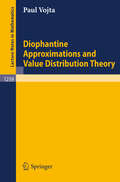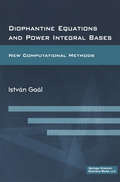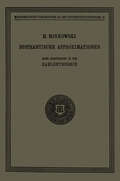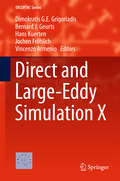- Table View
- List View
Diophantine Approximations and Value Distribution Theory (Lecture Notes in Mathematics #1239)
by Paul Alan VojtaDiophantine Equations and Power Integral Bases: New Computational Methods
by Istvan GaalWork examines the latest algorithms and tools to solve classical types of diophantine equations.; Unique book---closest competitor, Smart, Cambridge, does not treat index form equations.; Author is a leading researcher in the field of computational algebraic number theory.; The text is illustrated with several tables of various number fields, including their data on power integral bases.; Several interesting properties of number fields are examined.; Some infinite parametric families of fields are also considered as well as the resolution of the corresponding infinite parametric families of diophantine equations.
Diophantine Equations and Power Integral Bases: Theory and Algorithms
by István GaálWork examines the latest algorithms and tools to solve classical types of diophantine equations.; Unique book---closest competitor, Smart, Cambridge, does not treat index form equations.; Author is a leading researcher in the field of computational algebraic number theory.; The text is illustrated with several tables of various number fields, including their data on power integral bases.; Several interesting properties of number fields are examined.; Some infinite parametric families of fields are also considered as well as the resolution of the corresponding infinite parametric families of diophantine equations.
Diophantine Geometry: An Introduction (Graduate Texts in Mathematics #201)
by Marc Hindry Joseph H. SilvermanThis is an introduction to diophantine geometry at the advanced graduate level. The book contains a proof of the Mordell conjecture which will make it quite attractive to graduate students and professional mathematicians. In each part of the book, the reader will find numerous exercises.
Diophantine m-tuples and Elliptic Curves (Developments in Mathematics #79)
by Andrej DujellaThis book provides an overview of the main results and problems concerning Diophantine m-tuples, i.e., sets of integers or rationals with the property that the product of any two of them is one less than a square, and their connections with elliptic curves. It presents the contributions of famous mathematicians of the past, like Diophantus, Fermat and Euler, as well as some recent results of the author and his collaborators.The book presents fragments of the history of Diophantine m-tuples, emphasising the connections between Diophantine m-tuples and elliptic curves. It is shown how elliptic curves are used in solving some longstanding problems on Diophantine m-tuples, such as the existence of infinite families of rational Diophantine sextuples. On the other hand, rational Diophantine m-tuples are used to construct elliptic curves with interesting Mordell–Weil groups, including curves of record rank with agiven torsion group. The book contains concrete algorithms and advice on how to use the software package PARI/GP for solving computational problems.This book is primarily intended for researchers and graduate students in Diophantine equations and elliptic curves. However, it can be of interest to other mathematicians interested in number theory and arithmetic geometry. The prerequisites are on the level of a standard first course in elementary number theory. Background in elliptic curves, Diophantine equations and Diophantine approximations is provided.
Diophantische Approximationen (Ergebnisse der Mathematik und Ihrer Grenzgebiete. 1. Folge #4)
by J.F. KoksmaDieser Buchtitel ist Teil des Digitalisierungsprojekts Springer Book Archives mit Publikationen, die seit den Anfängen des Verlags von 1842 erschienen sind. Der Verlag stellt mit diesem Archiv Quellen für die historische wie auch die disziplingeschichtliche Forschung zur Verfügung, die jeweils im historischen Kontext betrachtet werden müssen. Dieser Titel erschien in der Zeit vor 1945 und wird daher in seiner zeittypischen politisch-ideologischen Ausrichtung vom Verlag nicht beworben.
Diophantische Approximationen: Eine Einführung in die Zahlentheorie (Mathematische Vorlesungen an der Universität Göttingen)
by Hermann MinkowskiThe Dirac Equation in Curved Spacetime: A Guide for Calculations (SpringerBriefs in Physics)
by Peter Collas David KleinThis book explains and develops the Dirac equation in the context of general relativistic quantum mechanics in a range of spacetime dimensions. It clarifies the subject by carefully pointing out the various conventions used and explaining how they are related to each other. The prerequisites are familiarity with general relativity and an exposure to the Dirac equation at the level of special relativistic quantum mechanics, but a review of this latter topic is given in the first chapter as a reference and framework for the physical interpretations that follow. Worked examples and exercises with solutions are provided. Appendices include reviews of topics used in the body of the text. This book should benefit researchers and graduate students in general relativity and in condensed matter.
Dirac Matter (Progress in Mathematical Physics #71)
by Bertrand Duplantier Vincent Rivasseau Jean-Nöel FuchsThis fifteenth volume of the Poincare Seminar Series, Dirac Matter, describes the surprising resurgence, as a low-energy effective theory of conducting electrons in many condensed matter systems, including graphene and topological insulators, of the famous equation originally invented by P.A.M. Dirac for relativistic quantummechanics. In five highly pedagogical articles, as befits their origin in lectures to a broad scientific audience, this book explains why Dirac matters. Highlights include the detailed "Graphene and Relativistic Quantum Physics", written by the experimental pioneer, Philip Kim, and devoted to graphene, a formof carbon crystallized in a two-dimensional hexagonal lattice, from its discovery in 2004-2005 by the future Nobel prize winners Kostya Novoselov and Andre Geim to the so-called relativistic quantum Hall effect; the review entitled "Dirac Fermions in Condensed Matter and Beyond", written by two prominent theoreticians, Mark Goerbig and Gilles Montambaux, who consider many other materials than graphene, collectively known as "Dirac matter", and offer a thorough description of the merging transition of Dirac cones that occurs in the energy spectrum, in various experiments involving stretching of the microscopic hexagonal lattice; the third contribution, entitled "Quantum Transport in Graphene: Impurity Scattering as a Probe of the DiracSpectrum", given by Hélène Bouchiat, a leading experimentalist in mesoscopic physics, with Sophie Guéron and Chuan Li, shows how measuring electrical transport, in particular magneto-transport in real graphene devices - contaminated by impurities and hence exhibiting a diffusive regime - allows one to deeply probe the Dirac nature of electrons. The last two contributions focus on topological insulators; in the authoritative "Experimental Signatures of Topological Insulators", Laurent Lévy reviews recent experimental progress in the physics of mercury-telluride samples under strain, which demonstrates that the surface of a three-dimensional topological insulator hosts a two-dimensional massless Dirac metal; the illuminating final contribution by David Carpentier, entitled "Topology of Bands in Solids: From Insulators to Dirac Matter", provides a geometric description of Bloch wave functions in terms of Berry phases and parallel transport, and of their topological classification in terms of invariants such as Chern numbers, and ends with a perspective on three-dimensional semi-metals as described by the Weyl equation. This book will be of broad general interest to physicists, mathematicians, and historians of science.
Dirac-Operatoren in der Riemannschen Geometrie: Mit einem Ausblick auf die Seiberg-Witten-Theorie (Advanced Lectures in Mathematics)
by Thomas FriedrichDieses Buch entstand nach einer einsemestrigen Vorlesung an der Humboldt-Universität Berlin im Studienjahr 1996/ 97 und ist eine Einführung in die Theorie der Spinoren und Dirac-Operatoren über Riemannschen Mannigfaltigkeiten. Vom Leser werden nur die grundlegenden Kenntnisse der Algebra und Geometrie im Umfang von zwei bis drei Jahren eines Mathematik- oder Physikstudiums erwartet. Ein Anhang gibt eine Einführung in das aktuelle Gebiet der Seiberg-Witten-Theorie.
Dirac Operators in Representation Theory (Mathematics: Theory & Applications)
by Jing-Song Huang Pavle PandzicThis book presents a comprehensive treatment of important new ideas on Dirac operators and Dirac cohomology. Using Dirac operators as a unifying theme, the authors demonstrate how some of the most important results in representation theory fit together when viewed from this perspective. The book is an excellent contribution to the mathematical literature of representation theory, and this self-contained exposition offers a systematic examination and panoramic view of the subject. The material will be of interest to researchers and graduate students in representation theory, differential geometry, and physics.
Dirac Spectra in Dense QCD (Springer Theses #124)
by Takuya KanazawaGaining a theoretical understanding of the properties of ultra-relativistic dense matter has been one of the most important and challenging goals in quantum chromodynamics (QCD). In this thesis, the author analyzes dense quark matter in QCD with gauge group SU(2) using low-energy effective theoretical techniques and elucidates a novel connection between statistical properties of the Dirac operator spectrum at high baryon chemical potential and a special class of random matrix theories. This work can be viewed as an extension of a similar correspondence between QCD and matrix models which was previously known only for infinitesimal chemical potentials. In future numerical simulations of dense matter the analytical results reported here are expected to serve as a useful tool to extract physical observables such as the BCS gap from numerical data on the Dirac spectrum.
Direct and Inverse Finite-Dimensional Spectral Problems on Graphs (Operator Theory: Advances and Applications #283)
by Manfred Möller Vyacheslav PivovarchikConsidering that the motion of strings with finitely many masses on them is described by difference equations, this book presents the spectral theory of such problems on finite graphs of strings. The direct problem of finding the eigenvalues as well as the inverse problem of finding strings with a prescribed spectrum are considered. This monograph gives a comprehensive and self-contained account on the subject, thereby also generalizing known results. The interplay between the representation of rational functions and their zeros and poles is at the center of the methods used. The book also unravels connections between finite dimensional and infinite dimensional spectral problems on graphs, and between self-adjoint and non-self-adjoint finite-dimensional problems. This book is addressed to researchers in spectral theory of differential and difference equations as well as physicists and engineers who may apply the presented results and methods to their research.
Direct and Inverse Methods in Radar Polarimetry (Nato Science Series C: #350)
by W. M. Boerner Leonard A. Cram William A. Holm David E. Stein Werner Wiesbeck Wolfgang Keydel Dino Giuli Dag T. Gjessing Édéric A. Molinet Hans BrandThis foreword deals exclusively with the planning, organization, and execution of the Workshop's scientific as well as cultural programs. It is opened with a synopsis on how the global political changes that occurred immediately after the Workshop caused the ~elay in producing the proceedings, followed by a brief exposition on need, timeliness, and importance of this second ARW in the field of electromagnetic imaging, radar remote sensing, and target versus clutter di~rimination; and an outline of the objectives. An informal discussion about some of the organizational details, a retrospective summary of events, and a preview of the third workshop, planned for 1993 September 19-25, is intended to recapture the spirit of this second NATO Advanced Research Workshop (1988 September 18-24), and will reveal how successful it was in compar ison to the first of 1983 September 18-24, how its accomplishments may be appreciated and why a third and last workshop was requested by its participants to take place during 1993 September 19-25.
Direct and Inverse Problems of Mathematical Physics (International Society for Analysis, Applications and Computation #5)
by R. P. Gilbert Joji Kajiwara Yongzhi S. XuThis volume consists of papers presented in the special sessions on "Wave Phenomena and Related Topics", and "Asymptotics and Homogenization" of the ISAAC'97 Congress held at the University of Delaware, during June 2-7, 1997. The ISAAC Congress coincided with a U.S.-Japan Seminar also held at the University of Delaware. The latter was supported by the National Science Foundation through Grant INT -9603029 and the Japan Society for the Promotion of Science through Grant MTCS-134. It was natural that the 'participants of both meetings should interact and consequently several persons attending the Congress also presented papers in the Seminar. The success of the ISAAC Congress and the U.S.-Japan Seminar has led to the ISAAC'99 Congress being held in Fukuoka, Japan during August 1999. Many of the same participants will return to this Seminar. Indeed, it appears that the spirit of the U.S.-Japan Seminar will be continued every second year as part of the ISAAC Congresses. We decided to include with the papers presented in the ISAAC Congress and the U.S.-Japan Seminar several very good papers by colleagues from the former Soviet Union. These participants in the ISAAC Congress attended at their own expense. This volume has the title Direct and Inverse Problems of Mathematical Physics which consists of the papers on scattering theory, coefficient identification, uniqueness and existence theorems, boundary controllability, wave propagation in stratified media, viscous flows, nonlinear acoustics, Sobolev spaces, singularity theory, pseudo differential operators, and semigroup theory.
Direct and Inverse Scattering for the Matrix Schrödinger Equation (Applied Mathematical Sciences #203)
by Tuncay Aktosun Ricardo WederAuthored by two experts in the field who have been long-time collaborators, this monograph treats the scattering and inverse scattering problems for the matrix Schrödinger equation on the half line with the general selfadjoint boundary condition. The existence, uniqueness, construction, and characterization aspects are treated with mathematical rigor, and physical insight is provided to make the material accessible to mathematicians, physicists, engineers, and applied scientists with an interest in scattering and inverse scattering. The material presented is expected to be useful to beginners as well as experts in the field. The subject matter covered is expected to be interesting to a wide range of researchers including those working in quantum graphs and scattering on graphs. The theory presented is illustrated with various explicit examples to improve the understanding of scattering and inverse scattering problems. The monograph introduces a specific class of input data sets consisting of a potential and a boundary condition and a specific class of scattering data sets consisting of a scattering matrix and bound-state information. The important problem of the characterization is solved by establishing a one-to-one correspondence between the two aforementioned classes. The characterization result is formulated in various equivalent forms, providing insight and allowing a comparison of different techniques used to solve the inverse scattering problem. The past literature treated the type of boundary condition as a part of the scattering data used as input to recover the potential. This monograph provides a proper formulation of the inverse scattering problem where the type of boundary condition is no longer a part of the scattering data set, but rather both the potential and the type of boundary condition are recovered from the scattering data set.
Direct and Inverse Sturm-Liouville Problems: A Method of Solution (Frontiers in Mathematics)
by Vladislav V. KravchenkoThis book provides an introduction to the most recent developments in the theory and practice of direct and inverse Sturm-Liouville problems on finite and infinite intervals. A universal approach for practical solving of direct and inverse spectral and scattering problems is presented, based on the notion of transmutation (transformation) operators and their efficient construction. Analytical representations for solutions of Sturm-Liouville equations as well as for the integral kernels of the transmutation operators are derived in the form of functional series revealing interesting special features and lending themselves to direct and simple numerical solution of a wide variety of problems.The book is written for undergraduate and graduate students, as well as for mathematicians, physicists and engineers interested in direct and inverse spectral problems.
Direct and Large-Eddy Simulation III: Proceedings of the Isaac Newton Institute Symposium / ERCOFTAC Workshop held in Cambridge, U.K., 12–14 May 1999 (ERCOFTAC Series #7)
by Peter R. Voke Neil D. Sandham Leonhard KleiserThe practical importance of turbulence led the U.K. Royal Academy of Engineering to launch an Initiative on Turbulence, the most important outcome of which was the definition and agreement of the 1999 Newton Institute Research Programme on Turbulence. The main aim of the- month programme, held at the institute in Cambridge, was to bring together the mathematics and engineering communities involved in the turbulence area to address the many problems and to map out future strategy. As a part of the Research Programme, a Symposium on Direct and Large-Eddy Simulation was jointly organised with ERCOFfAC through their Large-Eddy Simulation Interest Group and took place in May 1999. Two previous ERCOFf AC Workshops had already taken place on these closely related varieties of turbulence simulation, at The University of Surrey in 1994 and at Universite Joseph Fourier, Grenoble in 1996. The Symposium at Cambridge was therefore the third in the ERCOFTAC series, enhanced by the presence of leading figures in the field from Europe and the USA who were resident at INI for that period of the Research Programme. Professors M. Germano, A. Leonard, J. Jimenez, R. Kerr and S. Sarkar gave the invited lectures, text versions of which will be found in this volume. As occurred at the previous two ERCOFT AC workshops, there were almost one hundred participants mostly from Europe but including some from Japan and the USA, including on this occasion resident scientists of the INI Research Programme.
Direct and Large-Eddy Simulation IV (ERCOFTAC Series #8)
by Bernard Geurts Rainer Friedrich Olivier MétaisThis volume contains the proceedings of the 2001 DLES4 workshop. It describes and discusses state-of-the-art modeling and simulation approaches for complex flows. Fundamental turbulence and modeling issues but also elements from modern numerical analysis are at the heart of this field of interest.
Direct and Large-Eddy Simulation IX (ERCOFTAC Series #20)
by Jochen Fröhlich Hans Kuerten Bernard J. Geurts Vincenzo ArmenioThis volume reflects the state of the art of numerical simulation of transitional and turbulent flows and provides an active forum for discussion of recent developments in simulation techniques and understanding of flow physics. Following the tradition of earlier DLES workshops, these papers address numerous theoretical and physical aspects of transitional and turbulent flows. At an applied level it contributes to the solution of problems related to energy production, transportation, magneto-hydrodynamics and the environment. A special session is devoted to quality issues of LES. The ninth Workshop on 'Direct and Large-Eddy Simulation' (DLES-9) was held in Dresden, April 3-5, 2013, organized by the Institute of Fluid Mechanics at Technische Universität Dresden.This book is of interest to scientists and engineers, both at an early level in their career and at more senior levels.
Direct and Large-Eddy Simulation X (ERCOFTAC Series #24)
by Dimokratis G.E. Grigoriadis Bernard J. Geurts Hans Kuerten Jochen Fröhlich Vincenzo ArmenioThis book addresses nearly all aspects of the state of the art in LES & DNS of turbulent flows, ranging from flows in biological systems and the environment to external aerodynamics, domestic and centralized energy production, combustion, propulsion as well as applications of industrial interest. Following the advances in increased computational power and efficiency, several contributions are devoted to LES & DNS of challenging applications, mainly in the area of turbomachinery, including flame modeling, combustion processes and aeroacoustics.The book includes work presented at the tenth Workshop on 'Direct and Large-Eddy Simulation' (DLES-10), which was hosted in Cyprus by the University of Cyprus, from May 27 to 29, 2015. The goal of the workshop was to establish a state of the art in DNS, LES and related techniques for the computation and modeling of turbulent and transitional flows. The book is of interest to scientists and engineers, both in the early stages of their career and at a more senior level.
Direct and Projective Limits of Geometric Banach Structures. (Chapman & Hall/CRC Monographs and Research Notes in Mathematics)
by Patrick Cabau Fernand PelletierThis book describes in detail the basic context of the Banach setting and the most important Lie structures found in finite dimension. The authors expose these concepts in the convenient framework which is a common context for projective and direct limits of Banach structures. The book presents sufficient conditions under which these structures exist by passing to such limits. In fact, such limits appear naturally in many mathematical and physical domains. Many examples in various fields illustrate the different concepts introduced. Many geometric structures, existing in the Banach setting, are "stable" by passing to projective and direct limits with adequate conditions. The convenient framework is used as a common context for such types of limits. The contents of this book can be considered as an introduction to differential geometry in infinite dimension but also a way for new research topics. This book allows the intended audience to understand the extension to the Banach framework of various topics in finite dimensional differential geometry and, moreover, the properties preserved by passing to projective and direct limits of such structures as a tool in different fields of research.
Direct and Projective Limits of Geometric Banach Structures. (Chapman & Hall/CRC Monographs and Research Notes in Mathematics)
by Patrick Cabau Fernand PelletierThis book describes in detail the basic context of the Banach setting and the most important Lie structures found in finite dimension. The authors expose these concepts in the convenient framework which is a common context for projective and direct limits of Banach structures. The book presents sufficient conditions under which these structures exist by passing to such limits. In fact, such limits appear naturally in many mathematical and physical domains. Many examples in various fields illustrate the different concepts introduced. Many geometric structures, existing in the Banach setting, are "stable" by passing to projective and direct limits with adequate conditions. The convenient framework is used as a common context for such types of limits. The contents of this book can be considered as an introduction to differential geometry in infinite dimension but also a way for new research topics. This book allows the intended audience to understand the extension to the Banach framework of various topics in finite dimensional differential geometry and, moreover, the properties preserved by passing to projective and direct limits of such structures as a tool in different fields of research.























